Business analytics is essential to business growth and is absolutely vital for an enterprise to survive in today's competitive market. Business decisions cannot be made based on assumptions or guesswork; it takes precise reports and insights for an enterprise to define its strategies.
The precision of business intelligence reports and insights depend on the underlying data, and that is why data is the backbone of business intelligence. Acquiring, storing, and analyzing data are important processes that fuel analytics systems, applications, and other business platforms that function on data.
In this article, we will look into data warehousing and its role in enhancing business intelligence processes.
What is a Data Warehouse
A 'data warehouse' is a central repository for data storage and acts as a data source for analytics and business intelligence systems. It is designed to allow data scientists, business analysts, and other users to run queries and analyze historical and current data that is acquired from other transactional databases.
The data warehouse is fed data on one end from multiple transactional systems, and this data is accessed on the other end by end-user systems like business intelligence platforms, reporting tools, SQL clients, and other analytics applications.
The Difference Between a Database and a Data Warehouse
A data warehouse differs from a database in its underlying table structure and end-use. A transactional database is designed for fast data entry and updates and is built for the application that is running on top of this database. An example is a CRM that has its own database.
This database cannot be directly used by any other application except for the CRM that is built on top of it. It also stores the most current data and not historical data (which is removed from the database table when it is deleted from the front-end application).

An example of a transactional database built on the 3NF data modeling technique. Data is stored in many small tables that make read/write operations quick for individual parts of the application.
In a data warehouse, on the other hand, the underlying table structure is built for efficient data reads. It is designed to pull data from multiple transactional databases, process it to match a standard format, and organize it so that data is readily accessible to developers and analysts.
This allows the business to build different analytics systems that will use queries to retrieve data directly from a single data source - the data warehouse. Another difference is that data in a data warehouse is both current and historical.
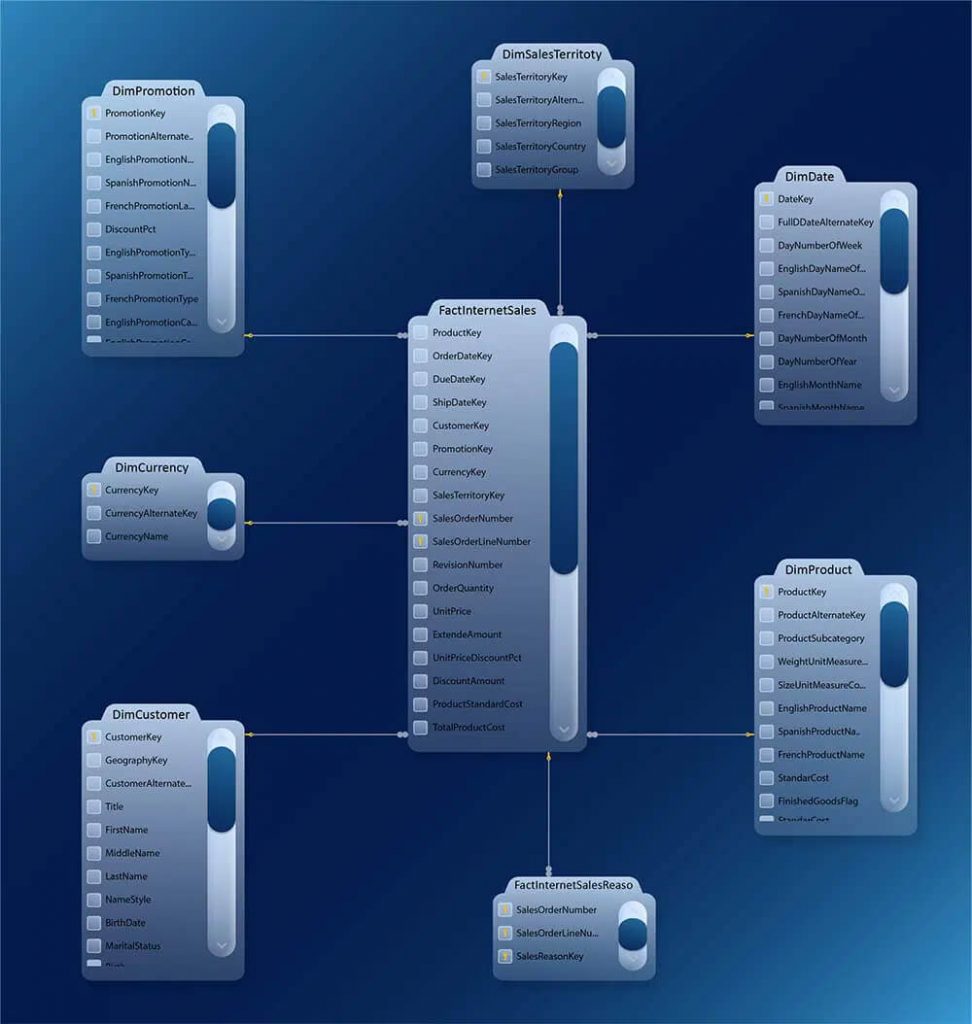
An example of a data warehouse storage server built on the dimensional modeling data modeling concept. Here, data is processed and organized into facts and dimensions, making it easy for the analytics system to use.
How a Data Warehouse Works - The Three-Tier Architecture
The data warehouse architecture is usually made of three tiers:
- Bottom Tier (the data warehouse storage server)
- Middle Tier (OLAP server for analytical processing)
- Top Tier (front end BI and analytics tools)
Data from multiple sources (either from databases within the organization or imported from external sources) is extracted, loaded and stored in the bottom tier - the storage server. This data can be structured or unstructured (although uncommon).
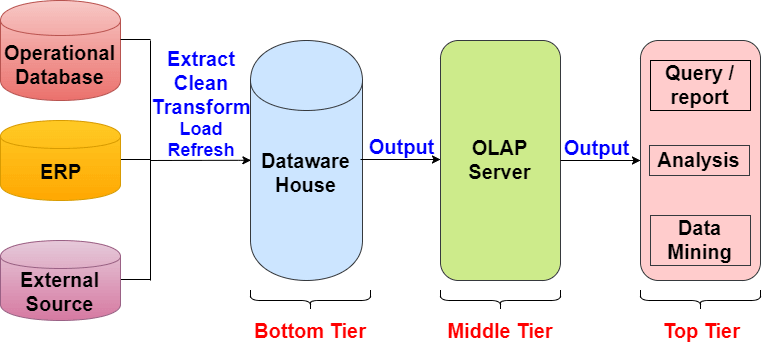
The middle tier, the Online Analytical Processing (OLAP) server, processes and analyses the data in the storage server and prepares it for the front-end analytics system.
The business intelligence and analytics tools on the top tier present the data analyzed by the OLAP server to the user through their graphical interface. It runs queries to pull specific analytics results from the OLAP server and presents them within the dashboard.
The Advantages of Implementing a Data Warehouse
- By providing all historical and current data in one location and in the right format, a data warehouse allows analytics systems to deliver insights faster, saving time. The turnaround time for reporting and analytics is drastically reduced.
- A data warehouse extracts data from multiple data silos and processes it into a single format. This makes the data format and quality consistent allowing developers and analysts to use it easily. It also means data will be compliant with company policies.
- Business intelligence processes are enhanced. Analysts can access data accumulated from multiple applications within the organization and use it to derive insights. This data might not have been available previously because of the disparate nature of transactional databases within an organization.
- Ad hoc reporting is much faster with a data warehouse as the BI system does not need to wait for the transactional source to process and deliver the data needed to generate reports. All data is stored, processed, and ready to be used within a data warehouse.
- Faster BI insights lead to better and faster business decisions. You also get better use of the data being collected within different application databases. All of this results in better ROI for the company.
- The data warehouse becomes a repository for historical data, which traditional databases do not store. This allows you to maintain lean and current transactional databases while storing all historical data within the data warehouse.
- By storing data in one repository, you reduce security risk and effort.
- A data warehouse introduces consistency in organizational information, in terms of format and availability.
The Disadvantages of Implementing a Data Warehouse
- Homogenizing data coming from multiple sources can be a challenge. It could also sometimes result in the loss of data.
- While the ready-to-use analytics data makes the front-end applications work fast, the ETL (Extract, Transform, and Load) process can be slow increasing production time.
- The investment in technology and personnel can be a lot for small and mid-sized organizations.
- The business will need to maintain compliance with the individual data sources. If the CRM from which data is being extracted has a compliance policy in place, for example, it will have to be adhered to even within the data warehouse.
- Integrating a data warehouse into the organization can be a complex process requiring advanced technical skills.
Three Types of Data Warehouses
1. Enterprise Data Warehouse (EDW)
An enterprise data warehouse is the complete version of a data warehouse and is what this article has covered so far. An EDW is a central repository that extracts and stores data from multiple disparate sources within the organization.
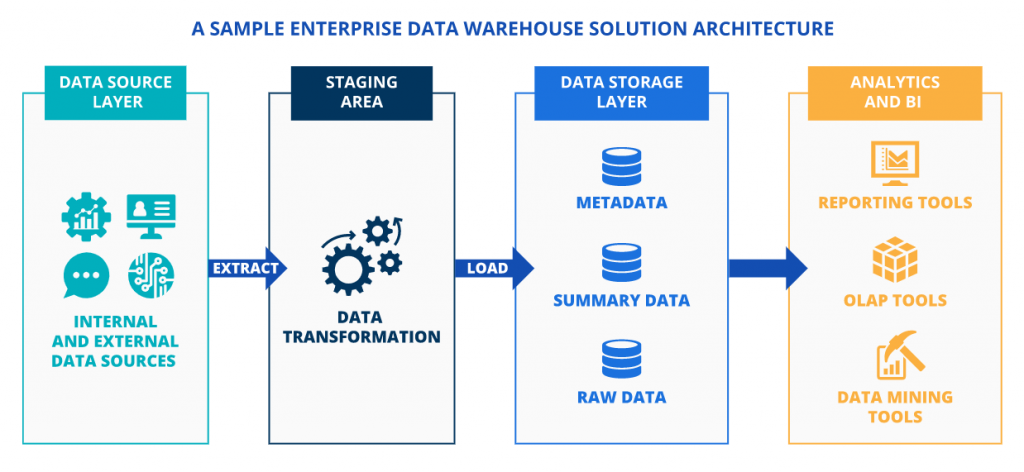
It stores historical and current data that is used by BI and analytics systems to generate insights and reports.
2. Data Mart
A data mart is a dialed down or simpler form of a data warehouse that is designed for a single organizational department (or function), such as sales, marketing, or accounting.
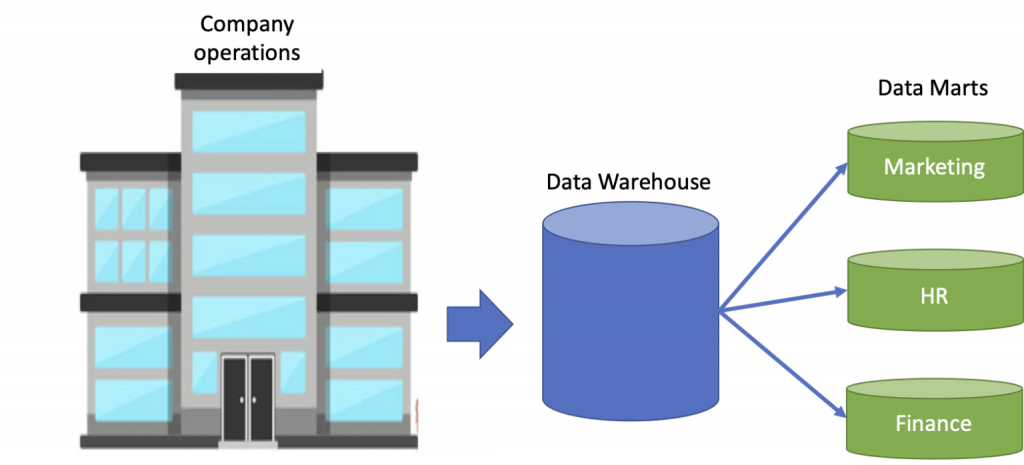
The data mart extracts data specific to the department that it is built for from selected sources (which can be separate databases, the data warehouse, or external data) and prepares it for analysis and reporting. Data marts are faster and easier to implement.
3. Operational Data Store
An operational data store (ODS) is a complementary database to the enterprise data warehouse. The operational data store provides the enterprise data warehouse with the ability to perform additional operations on the data for enhanced reporting, controls, and operational decision-making.

Who Should Implement a Data Warehouse?
While data warehouses are designed to help analysts, data scientists, and data engineers, any decision-maker within the organization will benefit from a data warehouse. Here's why your business probably needs a data warehouse:
- If your teams rely heavily on spreadsheets for data storage, you will end up with huge data silos as the business grows, and using this data will become more and more complex.
- The same goes for disparate database systems. If you have multiple systems (reporting or applications) that store data, you will eventually end up with data silos. Merging data from multiple different sources for a front-end BI tool will then be a complex challenge, something a data warehouse solves by merging data from the source and storing it in a single location.
- If the time taken to generate reports or insights is high, it will affect decision-making. This is often the case with organizations that have a lot of data stored in separate systems. Because a data warehouse extracts data from different locations and then uses an OLAP server to analyze and organize it, the front-end platforms have quick and ready access to processed data making it easier and faster to generate reports and insights.
- When different departments use different tools that have their own data sources that are disparate from each other, you will see inconsistency and discrepancies in reporting and analytics. A data warehouse solves this by making data available in a single repository and all departments use the same single source, ensuring consistency in reporting and analytics.
- If you collect or generate huge volumes of data and it is stored in different sources, using it for business intelligence or analytics will be time-consuming and inefficient. When you implement a data warehouse, the ETL process might be time-consuming but front-end users will experience fast results when it comes to actually use the data for reporting and analytics.
Use Cases for Data Warehouses
1. Reporting
Because data warehouses store complete organizational data, they are excellent for creating robust and detailed reports. A data warehouse is ideal for getting a global view of your business or a magnified view of a single department because all the data is available in one location. Data warehouses deliver optimized performance (since queries execute fast) making report generation a quick activity.
2. Business intelligence
A data warehouse unifies all BI and decision-making processes. With all the data available in one repository, every department within the organization - sales, marketing, finance, and so on, can use BI tools to generate analytics and insights for better decision-making.
3. Big data
A data warehouse is not a big data solution per se. Although it stores data from multiple sources in one location, its primary purpose is to prepare this data for reporting and analytics. That being said, if you cannot implement a big data solution for reasons like cost or time, you can use a data warehouse to unify data storage and processing within your organization.
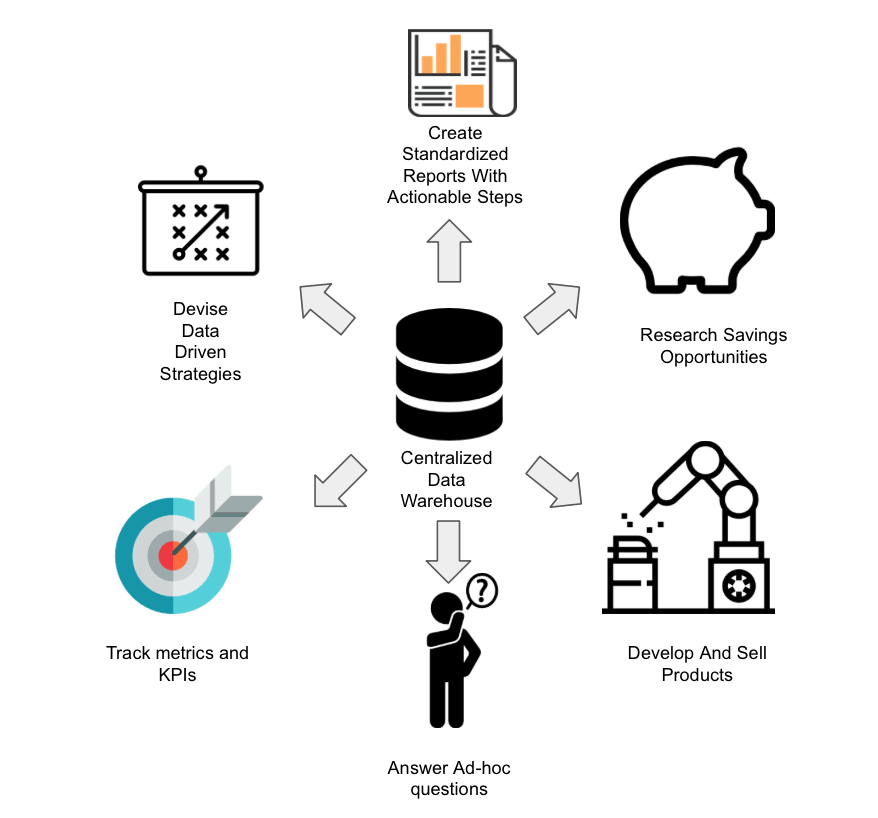
4. Natural language processing (NLP)
NLP-enabled data analytics platforms make it easy for anyone, even less technical users, to derive insights from the platform. By understanding the user's intent, the NLP program runs the right queries and generates insights using the underlying data that is stored within the data warehouse.
5. Auditing and compliance
A data warehouse (or a data mart built for the auditing and compliance department) can greatly reduce the time for auditing and compliance activities. Data stored on disparate systems will take much longer to be audited as compared to data that is available within a single source - the data warehouse.
6. Improving the quality and consistency of data quality
One important advantage of a data warehouse is that it can resolve database errors that exist in individual systems during the ETL process. It also stores data in a unified format. Both of these operations improve the quality of data and make it more consistent. Developing tools on top of this data becomes much easier and faster.
Final Thoughts
Many machine learning tools and analytics systems today, like QlikView, Looker, and Tableau, enable the slicing and dicing of data to create reports and analytics dashboards. Because a data warehouse organizes data into fact tables, it is easier to slice and dice this data for analytics, thus enhancing the performance of these systems.
A data warehouse will be an important component of business intelligence for any organization that relies on analytics and reports, which in today's day and age, is basically every organization. Data warehouses are designed to serve BI processes.
The underlying technology is built to enhance report and analytics generation. If you want to arm your decision-makers with solutions that deliver analytics insights and reports faster and accurately, you should consider implementing data warehousing technology.














Leave a Reply